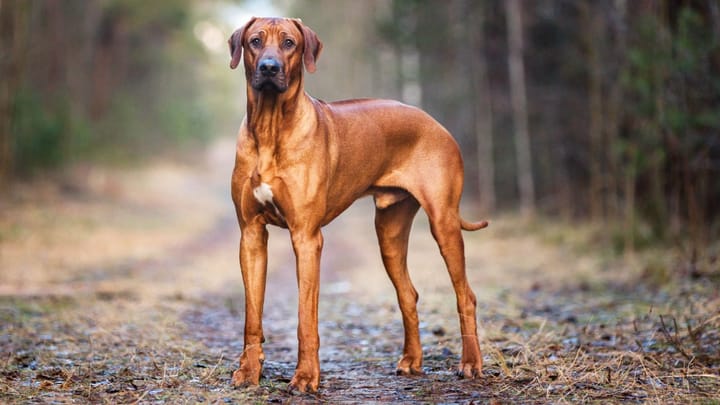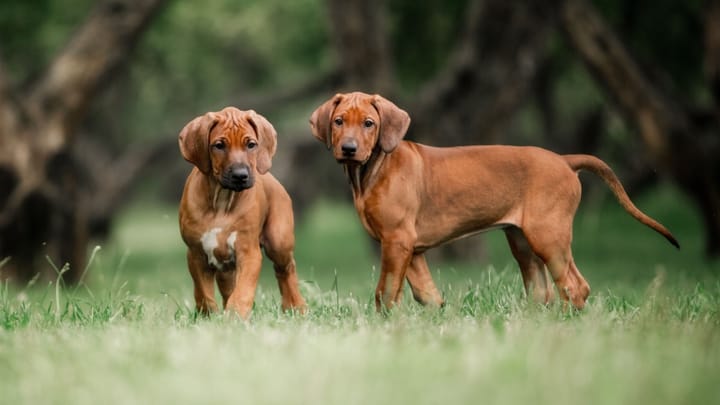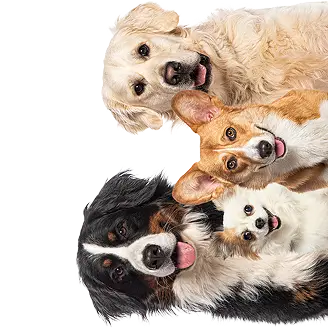Rhodesian Ridgeback
Other names : African Lion Hound, Lion dog


The Rhodesian Ridgeback, once known as the African Lion Dog, is a lively and courageous breed with a strong, loyal nature. Originally developed for lion hunting, this intelligent dog played a key role by alerting hunters to nearby predators and skilfully distracting them to bring them within range. Despite their fearless past, Ridgebacks are known for being good-natured and devoted to their families, including children.
|
Life expectancy |
The Rhodesian Ridgeback has a life expectancy of between 10 and 12 years |
|
Temperament |
|
|
Size |
Large
|
|
Adult size |
Female
Between 24 and 26 in
Male
Between 25 and 27 in
|
|
Adult weight |
Female
Between 71 and 79 lb
Male
Between 71 and 79 lb
|
|
Coat colour
The Rhodesian Ridgeback’s coat ranges in colour from light wheaten to rich red wheaten. A small amount of white on the chest and paws is acceptable, but excessive white markings |
Red Sand |
|
Type of coat
The Rhodesian Ridgeback has a short, dense coat that is smooth, glossy, and never woolly or silky in texture. Its most distinctive feature is the ridge of hair that grows in the opposite direction to the rest of the coat. This ridge begins just behind the shoulders and runs down the spine to the hips, forming a clearly defined, symmetrical shape. Ideally, it includes two identical whorls of hair, known as “crowns”, positioned opposite each other. The ridge is the breed’s hallmark and a defining characteristic of its appearance. |
Short |
|
Eye colour
The eye colour usually matches the coat. |
Brown
|
|
Purchase price |
The Rhodesian Ridgeback costs between £780 and £1100 |
The Rhodesian Ridgeback remains relatively uncommon in Europe, which can make finding a puppy a challenge. Long waiting lists are not unusual, so patience is essential. Before committing, it’s important to be certain this is the right breed for your lifestyle and experience.
More details about the Rhodesian Ridgeback
Rhodesian Ridgeback: Origins and history
The exact origins of the Rhodesian Ridgeback remain somewhat mysterious. However, it is widely believed that the breed descends from dogs native to the Cape Colony, modern-day South Africa, crossed with pariah dogs and other ridgeback-type hunting breeds. The original breeding is attributed to the indigenous Khoikhoi people, who valued these dogs for their hunting ability and resilience. The distinctive ridge of hair along the back is found in only two regions worldwide: southern Africa and the area formerly known as Siam (now Thailand). It’s thought that the ridge trait may have spread to these regions via ancient trade routes, possibly during the slave trade. According to legend, the ridge is said to be a mark left by a lion’s claws, a nod to the breed’s role in lion hunting. The Rhodesian Ridgeback was officially recognised by the Fédération Cynologique Internationale (FCI) in 1955.
Physical characteristics of the Rhodesian Ridgeback
The Rhodesian Ridgeback is a strong, muscular, and energetic breed, known for its symmetrical build, resilience, and speed. The head is of good length, broad and flat between the ears, and smooth in appearance when the dog is at rest. The muzzle is long, deep, and powerful, with a well-defined stop. The eyes are round, bright, and expressive. Ears are set high, of medium size, and lie close to the cheeks in a neat fold. The limbs are straight, sturdy, and well-boned, contributing to the breed’s athleticism. The tail is carried slightly upward in a gentle curve but should never curl over the back.
FCI classification of the Rhodesian Ridgeback
-
Group 6 - Scent hounds and related breeds
-
Section 3 : Related breeds
Rhodesian Ridgeback: Characteristics
Rhodesian Ridgeback: Behaviour
Training a Rhodesian Ridgeback
The Rhodesian Ridgeback can be a challenging breed to train, not due to a lack of intelligence, but because of it. Highly perceptive and quick to detect inconsistency, this breed may take advantage of unclear guidance or weak leadership.
As Ridgebacks tend to mature slowly, often not reaching full emotional maturity until around two years of age, training requires consistency, patience, and perseverance. Early socialisation and structured guidance from puppyhood are essential, and training should be seen as a lifelong process.
A strong, trusting bond between dog and owner is key to successful cooperation. This sensitive breed does not respond well to harsh methods; instead, calm, firm, and respectful training is the only effective approach.
Rhodesian Ridgeback: Lifestyle
Breed compatibility Rhodesian Ridgeback
Rhodesian Ridgeback: Purchase price
The cost of a Rhodesian Ridgeback can vary based on factors such as lineage, age, and gender. On average, expect to pay around £1,100 for a Kennel Club-registered puppy.
For ongoing care, the estimated monthly budget to meet the needs of a dog this size is approximately £45, covering essentials like food, basic healthcare, and routine supplies.
Rhodesian Ridgeback: Shedding
Light
The Rhodesian Ridgeback sheds very little, making day-to-day maintenance refreshingly simple, something even the most particular of owners are likely to appreciate.
Rhodesian Ridgeback: Grooming
The Rhodesian Ridgeback’s short, smooth coat is low maintenance. A weekly brush is usually sufficient to keep it clean, healthy, and looking its best. While generally robust and tolerant of poor weather, this breed dislikes being wet. After rainy walks, it’s important to dry them thoroughly to keep them comfortable and prevent any skin irritation.
Rhodesian Ridgeback: Health
The average life expectancy of a Rhodesian Ridgeback is approximately 11 years, although with proper care, some may live longer.
The Rhodesian Ridgeback is generally a robust and resilient breed with few health issues. However, like all dogs, they can be prone to certain hereditary conditions, so regular vet check-ups and responsible breeding are important to support long-term health.
Hardworking and deeply committed to any task, the Rhodesian Ridgeback is remarkably resilient and capable of withstanding a wide range of climates with impressive endurance.
Thanks to their resilience and weather tolerance, the Rhodesian Ridgeback can live both indoors and outdoors. However, they thrive best when given access to indoor comfort and close contact with their family.
The Rhodesian Ridgeback’s athletic build should be carefully maintained, as excess weight can place unnecessary strain on their joints and overall health. A balanced, nutritious diet tailored to their activity levels is essential to support their daily needs and keep them at a healthy weight.
Common Health Conditions in the Rhodesian Ridgeback:
- Cancer: as with many breeds, certain types of cancer can occur, particularly in later life
- Hip Dysplasia: a hereditary condition affecting the hip joint, potentially leading to arthritis or mobility issues
- Dermoid Sinus: a congenital skin defect that can cause infections if not treated; more common in this breed than others
- Congenital Myotonia: a rare muscle condition affecting movement and development
- Hypothyroidism: a hormonal imbalance caused by an underactive thyroid, which can lead to weight gain, lethargy, and coat issues
Regular health screenings and responsible breeding practices can help reduce the risk of these conditions.






